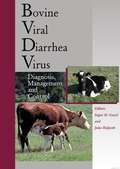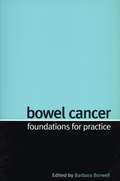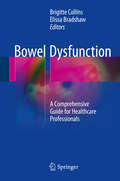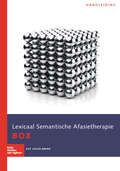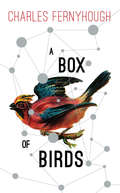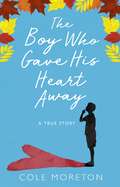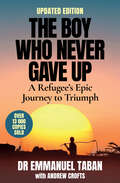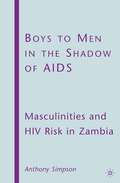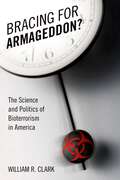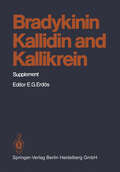- Table View
- List View
Bovine Viral Diarrhea Virus: Diagnosis, Management,and Control
by Sagar M. Goyal Julia F. RidpathFor almost 60 years, continual research on the subject of Bovine Viral Diarrhea (BVD) has raised as many questions as that research has answered. This common disease continues to cause sickness, death, abortion and fetal anomalies despite the millions of vaccination doses used each year to prevent its spread. Written by international experts on the subject of the BVD virus, BVDV: Diagnosis, Management and Control includes the latest information on BVD and outlines methods of diagnosis, management and control. Researchers, academics, and large animal practitioners will find this book an invaluable and irreplaceable resource for understanding and controlling outbreaks of BVD.
Bowel Cancer
by Barbara BorwellColorectal cancer is one of the most common killers of the 21st century. Bowel Cancer will develop the reader's knowledge and skills in both theory and practice and will enable nurses to demonstrate a good understanding of the problems posed by bowel cancer. This increased awareness provides opportunities for nurses to develop startegies that further enhance the quality and effectiveness of patient care. Acknowledging the vital role of a good working relationship for those engaged in the different aspects of care, the book provides a comprehensive introduction to colorectal cancer for all health professionals. From evolution and treatment to patient and family-centred care, including consideration of an individual's social, spiritual and psychological needs, either in the hospital or the community setting, Bowel Cancer is an excellent overall guide for all healthcare professionals.
Bowel Dysfunction: A Comprehensive Guide for Healthcare Professionals
by Brigitte Collins Elissa BradshawThe editors aim to provide the definitive guide for healthcare professionals on functional disorders of the gastrointestinal tract and pelvic floor, and the treatments used within the current healthcare context. This book will help the reader to access and understand relevant information within a variety of clinical settings and scenarios. It will be relevant and useful to a variety of disciplines (e.g. Physicians, Nurses, Physiotherapists) who work within the field of gastrointestinal care. This book will be written by a team from the worlds’ most well established colorectal specialist hospital, presenting a definitive guide to care of the patient group.
BOX handleiding: Lexicaal Semantische Afasietherapie
by Evy Visch-BrinkBOX is een therapieprogramma voor de behandeling van lexicaal-semantische stoornissen. Deze stoornissen komen frequent voor bij afasiepatiënten, onafhankelijk van het type afasie. De patiënt kent woordbetekenissen niet of niet volledig. 'Tram’ wordt bijvoorbeeld opgevat als ‘bus’ of in plaats van ‘lepel’ zegt men ‘vork’. Bij een ernstige lexicaal-semantische stoornis wijken de fouten nog meer af van het doelwoord. Ook komt het voor dat de patiënt niets zegt of de specifieke inhoudswoorden omzeilt door generalisaties (‘dingen’, ‘doen’ etc.). Het niet of gedeeltelijk onderkennen van woordbetekenis beïnvloedt het begrip en de productie van geschreven en gesproken taal.BOX bestaat uit 8 onderdelen: semantische categorieën, semantische gradiënt, syntagmatische en paradigmatische relaties, deel-geheel relaties, bijvoeglijke naamwoorden en uitroepen, semantische anomalieën, semantische definities en semantische context.In ieder onderdeel zijn twee of drie moeilijkheidsgraden verwerkt. De oefeningen worden in geschreven woorden aangeboden. De patiënt kan het antwoord zeggen en/of aanwijzen. BOX bestaat uit meer dan 1000 oefeningen en kan gebruikt worden voor minimaal 60 uur therapie.
A Box of Birds
by Charles FernyhoughNeuroscientist Dr Yvonne Churcher has problems in the world beyond her lab. One of her students, James, a dangerously attractive anti-science protestor, has set out to challenge her entire philosophy about how the brain works. His friend, Gareth, a brilliant, unstable computer genius, is obsessed with the biochemical basis of memory. When he tries to persuade Yvonne to get involved with a plan to stimulate memory artificially, it sets off a chain of events involving unscrupulous biotech companies, stolen brain-mapping data and a strange brand of eco-terrorism.A Box of Birds is both a pacy literary thriller set in a near-future world of experimental brain research, and a compelling love story between a neuroscientist and an animal rights campaigner. It brilliant dramatizes the clash between two of the predominant philosophical positions of our age: the materialist view that science has all the answers and that 'we' are nothing more than bundles of nerves and chemical reactions, and the Freud-inspired position that underpins the culture of psychotherapy: that the stories we tell about ourselves and our pasts have the capacity to change our future. Does neuroscience really change our understanding of who we are? Or are we all at the mercy of our own need to make coherent stories?
The Boy Who Gave His Heart Away: The True Story Of A Death That Brought Life
by Cole Moreton‘Gripping … so powerfully emotional that at times I had to put it down to wipe my eyes’Mail on Sunday ‘How do you say thank you to someone for giving you their heart? It is the greatest gift a person can ever give.’
The Boy Who Made Them Love Again: A Marriage Made In Italy / The Boy Who Made Them Love Again / The Cattleman's Ready-made Family (Mills And Boon Medical Ser.)
by Scarlet WilsonFrom Dr Storm to devoted dad
The Boy Who Never Gave Up: A Refugee’s Epic Journey to Triumph
by Emmanuel TabanIn 1994, 16-year-old Emmanuel Taban walked out of war-torn Sudan with nothing and nowhere to go after he had been tortured at the hands of government forces, who falsely accused him of spying for the rebels. When he finally managed to escape, he literally took a wrong turn and, instead of being reunited with his family, ended up in neighbouring Eritrea as a refugee.Over the months that followed, young Emmanuel went on a harrowing journey, often spending weeks on the streets and facing many dangers. Relying on the generosity of strangers, he made the long journey south to South Africa, via Ethiopia, Kenya, Tanzania, Mozambique and Zimbabwe, travelling mostly by bus and on foot.When he reached Johannesburg, 18 months after fleeing Sudan, he was determined to resume his education. He managed to complete his schooling with the help of Catholic missionaries and entered medical school, qualifying as a doctor, and eventually specialising in pulmonology.Emmanuel’s skills and dedication as a physician, and his stubborn refusal to be discouraged by setbacks, led to an important discovery in the treatment of hypoxaemic COVID-19 patients. By never giving up, this son of South Sudan has risen above extreme poverty, racism and xenophobia to become a South African and African legend. This is his story.
Boys to Men in the Shadow of AIDS: Masculinities and HIV Risk in Zambia
by A. SimpsonThis ethnography charts the lives of mission-educated men in Zambia and their search for meaning in the AIDS pandemic, as well as their responses to prevention and HIV testing. It also suggests how hegemonic masculinities may begin to be re-figured and gender relationships redesigned.
Brachial Plexus Injuries: Published in Association with the Federation Societies for Surgery of the Hand
by Alain GilbertThis is a comprehensive guide to the management of brachial plexus injuries. International experts have been assembled to comment on their areas of research and clinical experience, and the resulting volume is definitive.
Brachial Plexus Injuries: Published in Association with the Federation Societies for Surgery of the Hand
by Alain GilbertThis is a comprehensive guide to the management of brachial plexus injuries. International experts have been assembled to comment on their areas of research and clinical experience, and the resulting volume is definitive.
Brachial Plexus Lesions: Drawings of Explorations and Reconstructions by Algimantas Otonas Narakas
by BartSlooff ChantalBonnardThis unique text atlas on brachial plexus surgery and pathology describes 60 different lesions in very detailed and instructive color drawings by one of the foremost pioneers and experts in this field. After his death in 1993, Narakas is still greatly admired and many specialists are eagerly awaiting this book. Anatomical variations of the lesions, the problem and the surgical treatment are presented. Clinical data and follow-up of the patients are included with each lesion. Traumatic lesions, tumors and obstetric and irradiation lesions are presented.
Brachytherapy: An International Perspective (Medical Radiology)
by Paolo Montemaggi Mark Trombetta Luther W. BradyThis volume is the first truly international text to take the practitioner from the history, the physical basis, and the rationale of brachytherapy through to the techniques, the results, and the management of complications. It is also the first truly comprehensive and complete textbook of brachytherapy. The chapters on the physics of brachytherapy and the technical planning of internal and surface radiotherapy are designed to enhance the practitioner’s knowledge base and capabilities in this demanding specialty field. Disease site-specific chapters cover a wide range of applications, including ocular tumors, soft tissue sarcomas, cancers of the head and neck, skin, breast, lung, esophagus, and prostate, and gynecologic and anorectal malignancies. Each chapter incorporates the American and European guidelines and the text has been written from both perspectives by many of the most noted global experts in the field. A concluding chapter is devoted to brachytherapy quality assurance.
Brachytherapy: Techniques and Evidences
by Yasuo Yoshioka Jun Itami Masahiko Oguchi Takashi NakanoThis book provides a comprehensive and up-to-date overview of major technical advances and research findings in the field of brachytherapy. Especially research conducted on brachytherapy in Japan has made tremendous strides, offering readers valuable insights into new treatment outcomes, evidence and techniques. In the respective chapters, each author elucidates cutting-edge findings, addressing both the basic and clinical aspects including the application to various cancers, and especially focusing on highly valuable data gleaned in Japan. As such, the book will benefit not only radiation oncologists but also basic researchers, radiation technologists, medical physicists and members of medical staff who are involved in the development and utilization of this advanced therapy.
Bracing for Armageddon?: The Science and Politics of Bioterrorism in America
by William R. ClarkSince September 11th, the threat of a bioterrorist attack--massive, lethal, and unpreventable--has hung in the air over America. Bracing for Armageddon? offers a vividly written primer for the general reader, shedding light on the science behind potential bioterrorist attacks and revealing what could happen, what is likely to happen, and what almost certainly will not happen. The story opens with a riveting account of a bioterrorism scenario commissioned by the U.S. government. Using this doomsday tableau as a springboard, Clark reviews a host of bioterrorist threats (from agroterrorism to a poisoning of the water supply) and examines not only the worst-case menace of genetically engineered pathogens, but also the lethal agents on the CDC's official bioterrorism list, including Smallpox, Anthrax, Plague, Botulism, and Ebola. His overview of attempted bioterrorist attacks to date--such as the failed Aum Shinrikyo attempts in 1995 in Japan and the Anthrax attack in the US following 9/11--bolstered by interviews with a range of experts--shows why virtually all of these attempts have failed. Indeed, he demonstrates that a successful bioterrorism attack is exceedingly unlikely, while a major flu epidemic (such as the deadly epidemic of 1918 that killed millions worldwide) is a virtual certainty. Given the long odds of a bioterrorist attack, Clark asks, has the more than $40 billion the United States has dedicated to the defense against bioterrorism really been well spent? Is it time to move on to other priorities? In contrast to the alarmist fears stoked by the popular media, William Clark here provides a reassuring overview of what we really need to worry about--and what we don't.
Braddom's Physical Medicine and Rehabilitation E-Book
by David X. CifuThe most-trusted resource for physiatry knowledge and techniques, Braddom’s Physical Medicine and Rehabilitation remains an essential guide for the entire rehabilitation team. With proven science and comprehensive guidance, this medical reference book addresses a range of topics to offer every patient maximum pain relief and optimal return to function.In-depth coverage of the indications for and limitations of axial and peripheral joints through therapies enables mastery of these techniques.Optimize the use of ultrasound in diagnosis and treatment. A chapter covering PM&R in the international community serves to broaden your perspective in the field.Detailed illustrations allow you to gain a clear visual understanding of important concepts.New lead editor - Dr. David Cifu – was selected by Dr. Randall Braddom to retain a consistent and readable format. Additional new authors and editors provide a fresh perspective to this edition.Features comprehensive coverage of the treatment of concussions and military amputees.Includes brand-new information on rehabilitating wounded military personnel, the latest injection techniques, speech/swallowing disorders, head injury rehabilitation, and the rehabilitation of chronic diseases.New chapters on pelvic floor disorders and sensory impairments keep you at the forefront of the field.Reader-friendly design features an updated table of contents and improved chapter approach for an enhanced user experience.
Braddom's Physical Medicine and Rehabilitation E-Book: Braddom's Physical Medicine and Rehabilitation E-Book
by David X. CifuThoroughly updated to reflect the latest advances and technologies, Braddom’s Physical Medicine and Rehabilitation, 6th Edition, remains the market leader in the field of PM&R. For more than 20 years, this bestselling reference has been the go-to resource for the entire rehabilitation team, providing in-depth coverage of essential core principles along with the latest research, technologies, and procedures that enhance patient care and facilitate optimal return to function. In this edition, lead editor Dr. David X. Cifu and his team of expert associate editors and contributing authors employ a more succinct format that emphasizes need-to-know material, incorporating new key summary features, including high-yield information and study sheets for problem-based learning. Focuses more heavily on rehabilitation, with case studies throughout and more comprehensive coverage of stroke evaluation, rehabilitation, and therapies. Provides expanded information on key topics such as interventional pain management options, gait and prosthetics, USG, fluoroscopy, electrodiagnosis and more. Features a new chapter on Occupational Medicine and Vocational Rehabilitation, plus enhanced coverage of the neurogenic bladder, rehabilitation and prosthetic restoration in upper limb amputation, and acute medical conditions including cardiac disease, medical frailty, and renal failure. Discusses quality and outcome measures for medical rehabilitation, practical aspects of impairment rating and disability determination, integrative medicine in rehabilitation, and assistive technology. Offers highly illustrated, templated chapters that are easy to navigate without sacrificing coverage of key topics. Includes access to dozens of even more practical videos and hundreds of integrated self-assessment questions for more effective learning and retention.
Bradley's Neurology in Clinical Practice E-Book
by Robert B. DaroffComprehensive, easy to read, and clinically relevant, Bradley’s Neurology in Clinical Practice provides the most up-to-date information presented by a veritable "Who's Who" of clinical neuroscience. Its unique organization allows users to access content both by presenting symptom/sign and by specific disease entities—mirroring the way neurologists practice. A practical, straightforward style; templated organization; evidence-based references; and robust interactive content combine to make this an ideal, dynamic resource for both practicing neurologists and trainees.Authoritative, up-to-date guidance from Drs. Daroff, Jankovic, Mazziotta, and Pomeroy along with more than 150 expert contributors equips you to effectively diagnose and manage the full range of neurological disorders. Easy searches through an intuitive organization by both symptom and grouping of diseases mirrors the way you practice. The latest advances in clinical neurogenetics, brain perfusion techniques for cerebrovascular disease, the relationship between neurotrauma and neurodegenerative disease, management strategies for levodopa-related complications in movement disorders, progressive neuropsychiatric disorders arising from autoimmune encephalitis, and more keep you at the forefront of your field. Reorganized table of contents which includes new chapters on: Brain Death, Vegetative, and Minimally Conscious States; Deep Brain Stimulation; Sexual Dysfunction in Degenerative and Spinal Cord Disorders; Sports and Performance Concussion; Effects of Drug Abuse on the Nervous System; and Mechanisms of Neurodegenerative Disorders.
Bradley's Neurology in Clinical Practice E-Book
by Joseph Jankovic John C. Mazziotta Scott L. Pomeroy Nancy J. NewmanA practical, dynamic resource for practicing neurologists, clinicians and trainees, Bradley and Daroff's Neurology in Clinical Practice, Eighth Edition, offers a straightforward style, evidence-based information, and robust interactive content supplemented by treatment algorithms and images to keep you up to date with all that’s current in this fast-changing field. This two-volume set is ideal for daily reference, featuring a unique organization by presenting symptom/sign and by specific disease entities—allowing you to access content in ways that mirror how you practice. More than 150 expert contributors, led by Drs. Joseph Jankovic, John C. Mazziotta, Scott L. Pomeroy, and Nancy J. Newman, provide up-to-date guidance that equips you to effectively diagnose and manage the full range of neurological disorders.Covers all aspects of today’s neurology in an easy-to-read, clinically relevant manner. Allows for easy searches through an intuitive organization by both symptom and grouping of diseases. Features new and expanded content on movement disorders, genetic and immunologic disorders, tropical neurology, neuro-ophthalmology and neuro-otology, palliative care, pediatric neurology, and new and emerging therapies. Offers even more detailed videos that depict how neurological disorders manifest, including EEG and seizures, deep brain stimulation for PD and tremor, sleep disorders, movement disorders, ocular oscillations, EMG evaluation, cranial neuropathies, and disorders of upper and lower motor neurons, as well as other neurologic signs.
Bradykinin, Kallidin and Kallikrein: Supplement (Handbook of Experimental Pharmacology #25 / 1)
by K. D. Bhoola W. G. Clark R. W. Colman E. G. Erdös F. Fiedler T. L. Goodfriend L. M. Greenbaum A. R. Johnson M. Lemon A. P. Levitskiy H. S. Margolins R. Matthews I. H. Mills H. Z. Movat C. E. Odya T. S. Paskhina J. J. Pisano J. M. Stewart R. C. Talamo A. Terragno N. A. Terragno R. Vogel P. E. Ward P. Y. WongVolume XXV of the Handbook of Experimental Pharmacology series entitled "Bradykinin, Kallidin, and Kallikrein" was published in 1970. My aim in editing this volume of the series is not to replace, but to update the 1970 edition. During the decade preceding the publication of Vol. XXV, the existence of kinins and kallikreins gained acceptance, the protein components of the system were purified and characterized and the peptides were synthesized. Even after these accomplish ments, interest in the subject has not abated, but has increased substantially. We have learned a great deal about the role that components of the kallikrein-kinin system play in other systems and about the immensely complex and intricate inter actions in blood. Directly or indirectly, kallikrein and kinins affect the coagulation of blood, the activation of complement, and the generation of angiotensin. Kinins release or modulate the actions of other agents, including prostaglandins, histamine, and catecholamines. Inhibitors of kallikrein or kininase II are employed, for example, in extracorporeal circulation or in hypertension. Kallikrein, kinins, and kininases, present in urine, were described first in 1925 and 1954, but have been ignored for decades. These substances are now studied extensively because of their possible role in blood pressure regulation. The evidence that kinins have a metabolic function is also increasing. The abundance of active components of the system in genital organs suggests a role in the fertilization process. The book is organized into chapters which bear upon these issues.
Bradykinin, Kallidin and Kallikrein (Handbook of Experimental Pharmacology #25 / 2)
by Ervin G. Erdös Anne F. WildeBradykinin is frequently referred to as an elusive substance; the editor of a comprehensive volume dealing with kinins thus has a difficult task. The com plexity of the issues calls for a large number of contributors who approach the topics from the various angles that are dictated by the sometimes divergent views of the individuals. The editor saw no reason to prescribe the mode of presentation, which was left to the authors and accounts for the variety of approaches. Contributors from nine countries were asked to participate in the volume. The chapters were organized to present, first, the history of the discoveries and methods of approach to kinin research. Then follows a discussion of the enzymes that release kinins, their substrates, and other enzymes that inactivate the peptides. If the release of kinin is important, then the inhibition of the releasing enzymes is of obvious interest and is described. Since the measurement of kinin ogen levels in blood has been frequently used as an indicator of kinin liberation, in addition to a separate chapter, kininogens are also mentioned where the functions of kinins are discussed. The conclusions drawn from establishing structure-action relationships for many analogs and the actions of kinins are indicated and summarized.
BRAF Targets in Melanoma: Biological Mechanisms, Resistance, and Drug Discovery (Cancer Drug Discovery and Development #82)
by Ryan J. SullivanThis volume contains a collection of writings from the leaders in the fields of Molecular Biology and Melanoma Research which will begin to tell the ever-expanding story of the most recent findings, discoveries, and potential of BRAF-directed targets in melanoma. Recent research has shown that BRAF inhibitors are effective for a short period of time, but there is little hope that this drugs as single agents will lead to durable benefit in a majority of patients. Among scientists and researchers who work in drug discovery, there is a lot of interest in the development of molecularly targeted cancer agents. Namely, the identification of a molecular target, the selection of molecules which effectively inhibit this target. What is starkly different about the development of this class of compounds, however, is that the mechanism of action of these agents are not as straightforward as was once previously assumed and the mechanisms of resistance that tumor cells employ to evade complete destruction are unlike any that have been described before. These discoveries in addition to utilization of modern molecular biology techniques have led to a series of hypotheses regarding which other types of molecules could be used in combination with BRAF-inhibitors in hopes of revolutionizing the potential of therapeutics in melanoma.
Brain (A\medical Thriller Ser.)
by Robin CookTwo doctors suspect something is very wrong at the enormous medical center where they work. And soon they will put their careers–and their lives–in deadly jeopardy, as they penetrate the eerie inner sanctums of a medical world gone mad.
The Brain: An Introduction to Functional Neuroanatomy
by Charles Watson George Paxinos Matthew KirkcaldieThe authors of the most cited neuroscience publication, The Rat Brain in Stereotaxic Coordinates, have written this introductory textbook for neuroscience students. The text is clear and concise, and offers an excellent introduction to the essential concepts of neuroscience. Based on contemporary neuroscience research rather than old-style medical school neuroanatomy Thorough treatment of motor and sensory systems A detailed chapter on human cerebral cortex The neuroscience of consciousness, memory, emotion, brain injury, and mental illness A comprehensive chapter on brain development A summary of the techniques of brain research A detailed glossary of neuroscience terms Illustrated with over 130 color photographs and diagrams This book will inspire and inform students of neuroscience. It is designed for beginning students in the health sciences, including psychology, nursing, biology, and medicine. Clearly and concisely written for easy comprehension by beginning students Based on contemporary neuroscience research rather than the concepts of old-style medical school neuroanatomy Thorough treatment of motor and sensory systems A detailed chapter on human cerebral cortex Discussion of the neuroscience of conscience, memory, cognitive function, brain injury, and mental illness A comprehensive chapter on brain development A summary of the techniques of brain research A detailed glossary of neuroscience terms Illustrated with over 100 color photographs and diagrams
